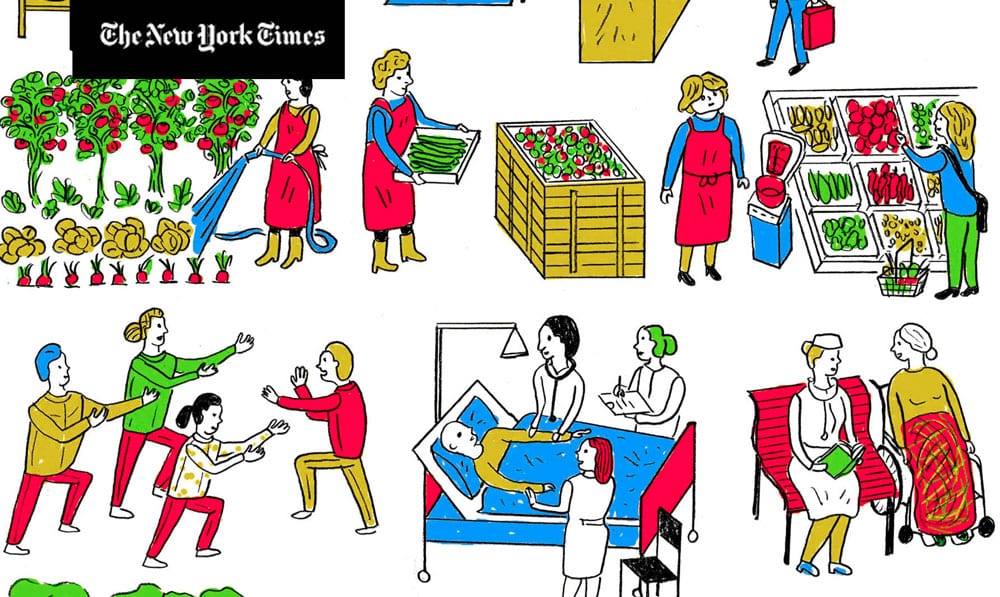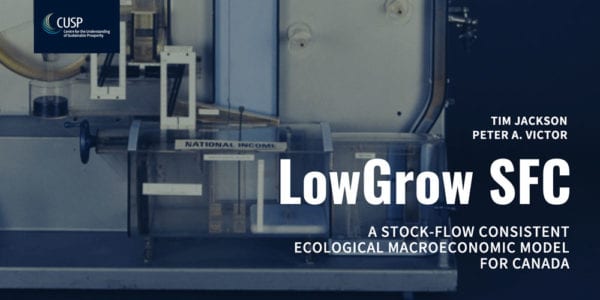Prosperity Matters
What can prosperity possibly mean in a world of environmental, social and economic limits?—We work with people, policy and business to address this question, developing pragmatic steps towards a shared and lasting prosperity.
Low Grow SFC: A stock-flow consistent ecological macroeconomic model for Canada
System dynamics model by Tim Jackson and Peter Victor, developing sustainable prosperity scenarios for the Canadian economy out to 2067. A CUSP working paper is outlining LowGrow SFC and various scenarios in detail. Desktop users can explore the model in the embedded online beta version below, or go directly to the ISEE page. For background about our system dynamics work, please see the project page.

Difficulties viewing the model? Please try the ISEE website directly for a full-screen view.
Since the end of the second world war, most countries have pursued economic growth as their top economic policy objective. Economic growth has brought enormous benefits to many people, especially those living in high income countries. However, it is increasingly obvious that the benefits of growth have not been equally shared. Far from it. Income and wealth inequality is on the rise and some of the economic growth in high income countries has come at the expense of poorer parts of the world. With accumulating evidence of environmental degradation, social disruption and population displacement, and with declining confidence in governments and corporations to deliver a good life for all, we need to choose the future we want rather than accept the disturbing consequences of current trends.
The first step is to imagine different possibilities. This is not easy. We need to start from where we are and to ground the alternatives in real data. To help do this Tim Jackson and Peter Victor have created a computer model of an economy that encompasses economic, environmental, energy, social and financial considerations. LowGrow SFC incorporates many features developed over several years of collaboration and brings together: 1) the environmental and resource constraints on economic activity; 2) a full account of production, consumption, employment and public finances in the ‘real economy’ at the level of the nation state; 3) a comprehensive account of the financial economy, including the main interactions between financial agents. The model is of a single high income country which happens to be Canada. Alternative futures derived from the model are likely to be similar for other advanced economies.
Three scenarios generated with the model describe alternative futures for Canada from 2017 to 2067. One scenario is a base case which is essentially a projection of the past into the future. The second scenario introduces a vigorous program of greenhouse gas reduction. The third scenario builds on the second by adding more environmental, social and economic measures that combine to provide sustainable prosperity. The scenarios are not predictions of what will happen, but an exploration of possibilities. Interested readers can explore the implications for themselves in the online beta version of LowGrow SFC.
About
LowGrow SFC is part of a suite of system dynamics models developed by Tim Jackson and Peter Victor, including SIGMA, which addresses the key challenge of inequality in the context of declining growth rates; and FALSTAFF, which explores the financial and economic dimensions of a post-growth economy.
The CUSP working paper No 16 is outlining LowGrow SFC in detail. The scenarios are developed in the recently published journal paper: The Transition to a Sustainable Prosperity (Ecological Economics, Vol 177).
Jackson, T and P Victor 2020. The Transition to a Sustainable Prosperity-A Stock-Flow-Consistent Ecological Macroeconomic Model for Canada. Ecological Economics, Vol 177.
Jackson T and P Victor 2019. Unravelling the claims for (and against) green growth. Science, 366 (6468): 950-951.
Victor, P 2019. Managing Without Growth—Slower by Design, Not Disaster. Edward Elgar.
Jackson, T 2018: The Post-Growth Challenge: Secular Stagnation, Inequality and the Limits to Growth. Ecological Economics, 156: 236–246.
Jackson, T 2017. Prosperity Without Growth—Foundations for the Economy of Tomorrow. Routledge.
Jackson, T, Victor, P and A Asjad Naqvi 2016. Towards a Stock – Flow Consistent Ecological Macroeconomics. WWW for Europe: Work Package 205, Milestone 40 “Report on model results including additional policies to counter averse effects“. Working Paper no 114.
Jackson, T and P Victor 2016. Does slow growth lead to rising inequality? Some theoretical reflections and numerical simulations. Ecological Economics, 121: 206–219.
Jackson, T and P Victor 2015. Does credit create a growth imperative? A quasi-steady state economy with interest-bearing debt. Ecological Economics, 120: 32–48.













